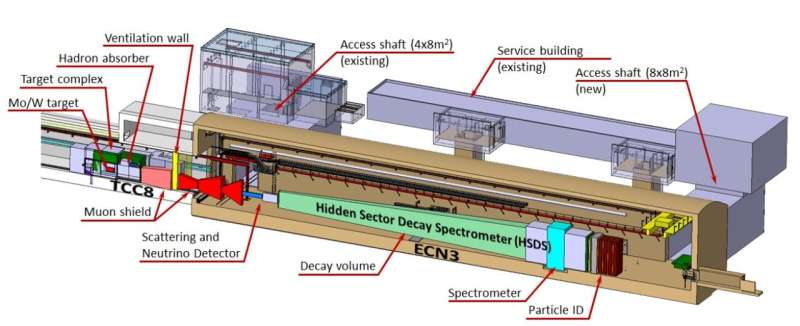This article has been reviewed according to Science X's editorial process and policies. Editors have highlighted the following attributes while ensuring the content's credibility:
fact-checked
trusted source
proofread
CERN gives green light to build new experiment to search for unknown particles

After many years of preparations, CERN has approved a new experiment: the Search for Hidden Particles (SHiP). Physicist Alexey Boyarsky was involved from the start. "We know there is physics that's missing and we aim to find it."
"Ultimately, we try to capture the whole universe in a single theory," says Boyarsky, who is professor of theoretical physics at the Leiden Institute of Physics. "The Standard Model seemed to be just that but there was always something missing. With the discovery of the Higgs boson in 2012, we thought the model was complete," he says. "But then we realized it couldn't be."
"This story started in 2006 when we were a few theorists with an idea. In 2013, we were 16 and published a letter of intent. Now it is a collaboration between 54 institutes in 18 countries. In Leiden, many researchers have already studied the theory behind SHiP and even promoted it."
"You see, we observe things that should be impossible according to the Standard Model. That's not something you can ignore." Three mysteries prevail, Boyarski explains. "Our first mystery is well-known: dark matter. Secondly, we learned that neutrinos have mass even though they shouldn't. And finally, there is much more regular matter than antimatter although we expect there to be an equal amount of either."
This means there must be new physics that's yet to be discovered, according to the professor. "It might just be some new particles. But it could also be something groundbreaking that requires us to rethink the basic concepts of physics."
Building a giant neutrino detector
For decades, the approach to finding new particles has been to build bigger and bigger particle accelerators, like the Large Hadron Collider at CERN. It takes many years and resources to build these machines, but so far without any signs of the missing physics that Boyarsky is chasing. "There is another type of experiment that could give us the answers we are looking for, but it has never been pursued."
The existing facilities focus on what is called the energy frontier. This is for relatively heavy, short-lived particles. You collide them at high speeds and they decay into other particles. Boyarsky and his colleagues propose to explore the intensity frontier. The hope is to observe more rare and lighter particles, that barely interact with anything. "I believe we have an equal chance of finding the missing physics at each of these frontiers."
The new detector will use a proton beam from an existing facility at CERN and clash it into a specially designed target. "This produces a lot of particles. The known ones will be filtered out and we will see what we are left with. Hopefully new particles," Boyarsky says. "Our challenge now is to start building as soon as possible. We can only do this when the current facility is shut down between cycles. The next opportunity is in 2026. If we miss it, we have to wait another six years."
"I am lucky enough to be working on many exciting projects. But this is definitely one of the most important moments in my career."
Provided by Leiden University





















